Physical Address
304 North Cardinal St.
Dorchester Center, MA 02124
Pelvic organ prolapse is defined as the descent of one or more compartments of the vagina: the anterior vaginal wall, posterior vaginal wall, uterus (cervix), or apex (vaginal vault or cuff scar after hysterectomy). Pelvic organ prolapse often includes a mixture of anterior, posterior, and apical prolapse, and each compartment should be evaluated under strain before determining the appropriate operative treatment.
Pelvic organ prolapse is more likely to be symptomatic when the leading edge protrudes past the hymen; it can be managed expectantly if asymptomatic.
Pessaries should be offered to all women with symptomatic pelvic organ prolapse. Renal function should be evaluated in women with advanced pelvic organ prolapse if the patient declines treatment to reduce the prolapse (because of concern for ureteral obstruction).
Surgery for pelvic organ prolapse is usually effective at decreasing a vaginal bulge, but the effects on urinary, bowel, and sexual function can vary. It is important to elicit patients’ goals before surgery.
The cardinal and uterosacral ligaments normally hold the uterus and upper vagina in the proper location. Uterosacral and sacrospinous ligaments are the best surgical support structures for apical transvaginal, native tissue pelvic organ prolapse surgery.
Vaginal vault prolapse can be repaired abdominally or vaginally. An abdominal sacral colpopexy with synthetic mesh appears to have a higher long-term success rates than vaginal surgery without mesh but with higher surgical complication rates.
All women with significant apical prolapse, anterior prolapse, or both should have a preoperative evaluation for occult stress urinary incontinence, with full bladder cough stress testing or urodynamic testing with the prolapse reduced.
The structural supports of the abdomen and pelvis are susceptible to a number of stresses. The development of defects might be affected by congenital anatomic predispositions, pregnancy, childbirth injuries, surgical damage, aging, and chronic stresses such as heavy lifting, chronic cough, and straining to defecate. Descent of the pelvic organs is called pelvic organ prolapse. It manifests as a vaginal bulge and is often associated with concurrent urinary, sexual, and bowel symptoms . It is rarely medically dangerous unless it is associated with evisceration or urinary obstruction, and it can range from asymptomatic or mildly symptomatic to severely debilitating.
A hernia is a protrusion or bulge of an organ or part of an organ through the body wall. The abdominal wall is made up of the following structures, beginning externally: skin; subcutaneous connective tissue; external oblique, internal oblique, and transversus abdominis muscles with their investing fascia; and parietal peritoneum. The rectus abdominis muscles run longitudinally in the midline from the xiphoid to the pubic symphysis. The investing fasciae of the external oblique, internal oblique, and transversus abdominis muscles completely encase the rectus abdominis muscles cephalad to the semilunar line. Caudally from the semilunar line the muscle is completely behind the aponeurosis of the fasciae of these muscles and lies directly on the peritoneum ( Fig. 20.1 ). Normally the investing fasciae join in the midline after surrounding the rectus abdominis muscles.
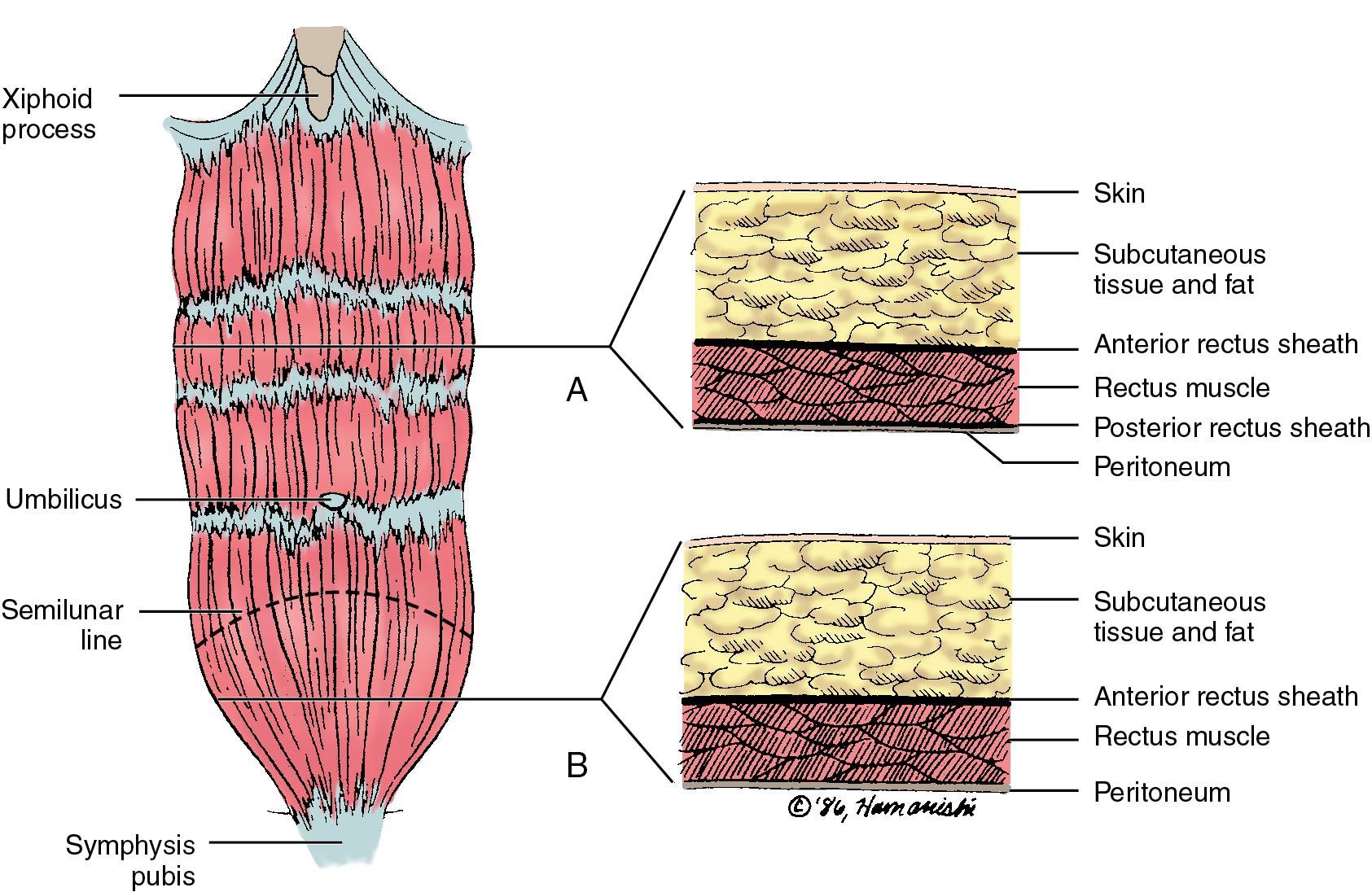
In the male, the descent of the testes from their original retroperitoneal site to the scrotum necessitates passing through the abdominal wall to the inguinal region. At the level of the transversalis fascia where the descent begins, the internal inguinal ring is formed. The inferior epigastric artery defines the medial margin of this ring as it courses from the external iliac artery medially and superiorly into the rectus sheath. The inguinal canal runs from the internal inguinal ring obliquely downward, emerging through the external inguinal ring and opening in the external oblique aponeurosis just above the pubic spine, and then continuing into the scrotum. This allows for passage of the testes and for the presence of part of the spermatic cord. In the female, the round ligament courses in the same direction but ends short of the labia.
Common hernias are ventral (incisional and umbilical) and groin (inguinal and femoral). Rarer hernias are Spigelian and parastomal. An inguinal hernia—that is, a bulge of peritoneum through the internal inguinal ring and into the inguinal canal—is less common in the female than in the male and is often identified after stretching of the abdominal wall during or after pregnancy. It may be related to a congenital weakness of this area. Occasionally a femoral-type groin hernia may develop. In this case the defect in the transversalis fascia occurs in the Hesselbach triangle, which is an area bounded laterally by the inferior epigastric artery, inferiorly by the inguinal ligament, and medially by the lateral margin of the rectus sheath ( Fig. 20.2 ). The hernia sac passes under the inguinal ligament into the femoral triangle rather than coursing through the inguinal canal. Femoral hernias are more common in females than in males and have higher risk of strangulation ( ).
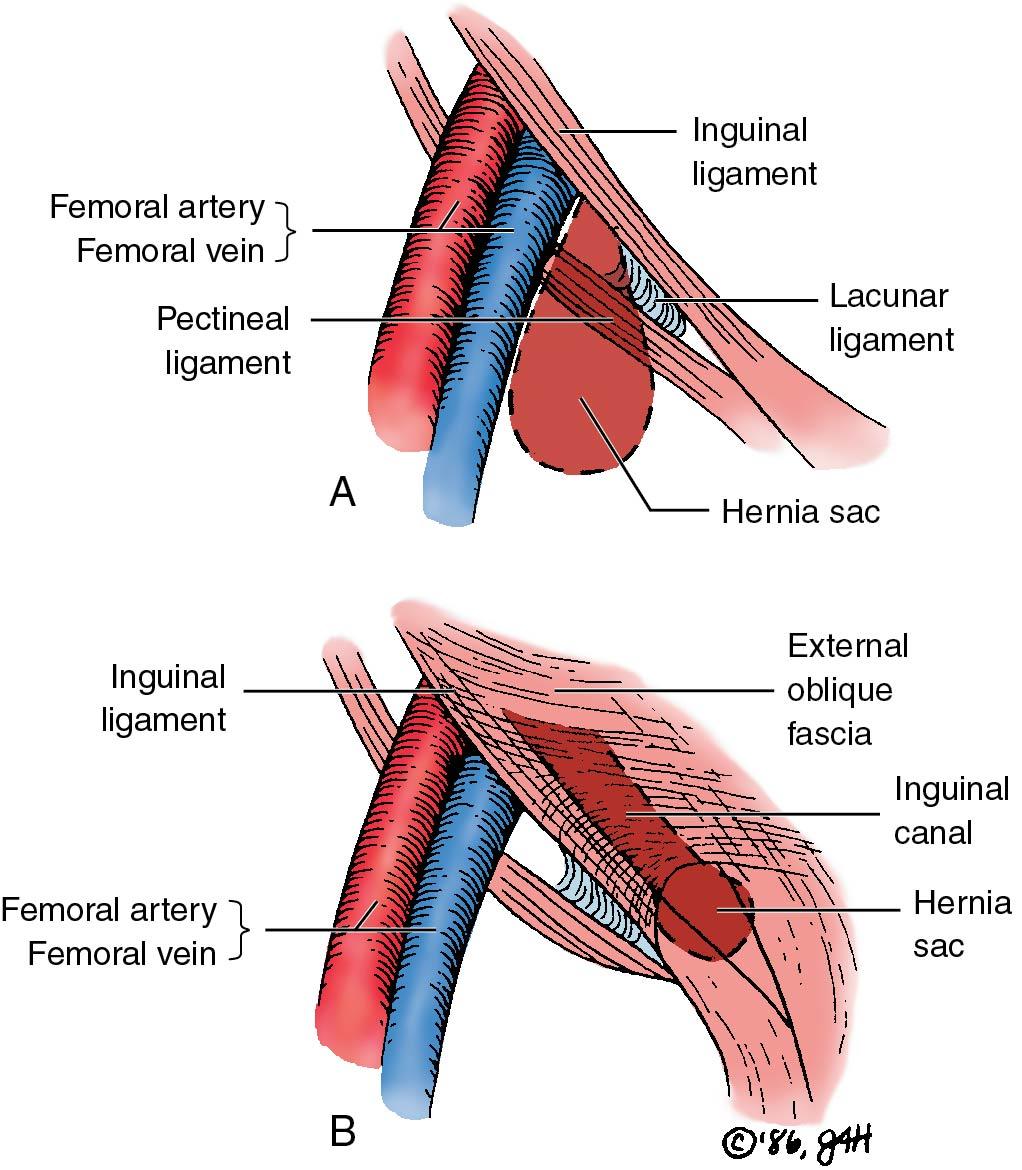
A ventral hernia occurs in the abdominal wall away from the groin. Examples include umbilical hernias, which are caused by congenital relaxation of the umbilical ring, and incisional hernias, which are herniations through separation of fascial planes after operative incision. Umbilical hernias are more common in women than men. Incisional hernias generally involve the separation of the fascia of the abdominal wall with the hernia sac palpated beneath the skin and subcutaneous tissue. The sac wall is composed of peritoneum. Because the umbilicus consists of a fusion of skin, fascia, and peritoneum, an umbilical hernia generally occurs because the fascial ring is grossly separated, allowing the hernia sac to protrude. This occurs most often in obese women. The hernia sac itself is made up of peritoneum and subcutaneous tissue beneath the skin ( Fig. 20.3 ). Two special ventral hernias include the epigastric hernia, which occurs in a defect of the linea alba above the umbilicus, and spigelian hernia, which is a herniation at a point where the vertical linea semilunaris joins the lateral border of the rectus muscle. Spigelian hernias are rare (<2% of all hernias).
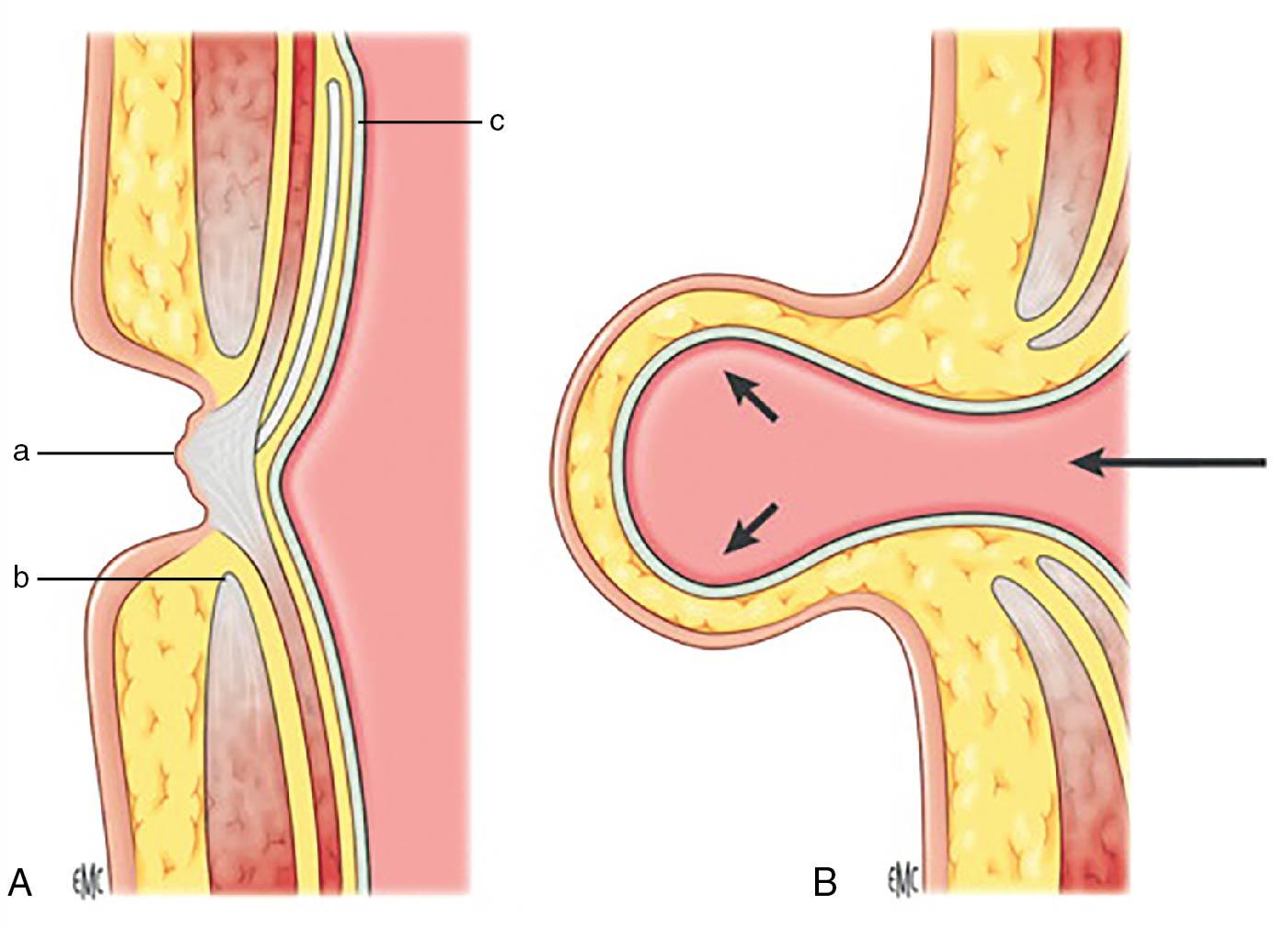
With a reducible hernia, the contents can be returned to the abdominal cavity. If the contents cannot be reduced, the hernia is said to be incarcerated. An incarcerated hernia may be acute, accompanied by pain, or long-standing and asymptomatic. If the blood supply to the incarcerated structure is compromised, the hernia is said to be strangulated. Because the hernia sac is primarily prolapsed peritoneum, the hernia itself is not strangulated but only its contents. On rare occasions, a portion of the wall of the hernia sac is composed of an organ such as the sigmoid colon or the cecum.
Rectus abdominis diastasis is an acquired abdominal wall defect in which the rectus muscles on either side of the midline separate. This is not a true hernia because there is no fascial defect , but it is mentioned here for differential diagnosis purposes. Pregnancy is a common risk factor for rectus diastasis.
Hernias may be the result of a congenital malformation. The umbilical hernia is the best example . Before 10 weeks’ gestation, the abdominal contents are partially herniated through the umbilicus into the extra embryonic coelomic cavity; however, after 10 weeks the viscera normally return to the abdominal cavity, and the defect in the abdominal wall closes during subsequent fetal growth. Generally at birth only the space occupied by the umbilical cord remains patent. After the cutting of the cord, the area heals so that the skin in the area of the umbilicus fuses above the closed fascial layer. Some infants at birth will show a small umbilical hernia, but in most instances the fascial defect closes during the first 3 years of life. If it does not close, an umbilical hernia will form. Black infants have umbilical hernias more often than do white infants. Occasionally, umbilical hernias are acquired in adults after the distention of the abdominal cavity with pregnancy or with ascites.
In rare cases the abdominal wall closure process is less complete during gestation, leading to an omphalocele, which is a hernia sac at the umbilicus covered only by peritoneum and including bowel and other abdominal contents. Omphaloceles are usually seen in infants with other malformations and possibly chromosome anomalies, such as trisomy 13.
Hernias that occur in adults are often associated with trauma or injury. In many instances, the hernia bulge develops slowly after years of heavy labor. It is likely that a congenital anatomic defect was always present but became exaggerated over time, leading to the development of a hernia. It has been suggested that inguinal lesions resulted from inadequate muscle support at the lower area of the inguinal canal, primarily caused by a defect in the internal oblique muscle. Stretching of this area in pregnancy may initiate a hernia, but multifactorial reasons are likely responsible.
Summarized risk factors for hernia development are:
History of prior hernia
Male sex
Caucasian race
Chronic cough
Chronic constipation
Abdominal wall injury
Smoking
Family history of hernia
Incisional hernias generally occur because of poor healing of the fascia after surgery. Risks factors for incisional hernias are usually multifactorial:
Vertical midline incision
Upper abdominal incision
Older age
Obesity
Smoking
Connective tissue diseases
Malnutrition
Wound infection
Excessive tension on the fascial closure with resultant necrosis of the fascia secondary to suturing
Incisional hernias may also occur because absorbable suture loses its tensile strength before healing is complete. Stress and strain secondary to chronic cough or vomiting in the postoperative period may contribute to the process. Emergency surgery increases the risk of incisional hernia. Incisional hernias develop in 10% to 15% of patients after abdominal laparotomy incisions.
Bulges in the abdominal wall lead to the discovery of most ventral or groin hernias in women, either by a physician at the time of physical examination or by the patient . Occasionally, excessive straining or trauma will be implicated, and the patient may experience a feeling of tearing of tissue. Often the bulges are noted during an increase in intraabdominal pressure such as with coughing, pregnancy or lifting. Most hernias are asymptomatic, but in some cases, particularly with larger ones, there may be aching or discomfort. Should intraabdominal organs move into the sac, the patient may experience some discomfort. Organs that strangulate within the sac cause acute pain and discomfort. Incarcerated organs may give nonspecific visceral pain, which is most likely the result of mesenteric stretching. An incisional hernia with incarceration may present with a bowel obstruction.
In cases in which a hernia exists but no contents are within the sac, physical examination reveals a weakening at the site of the hernia. It is often possible to feel the “ring” of the hernia as one palpates the defect through the skin and subcutaneous tissue. The patient’s straining will generally accentuate the hernia, making it more palpable and visible. In the case of inguinal and femoral hernias, it may be necessary for the patient to be standing for one to palpate the hernia.
When there are intraabdominal contents within the hernia sac, the hernia is more easily palpated. The physician should then decide, based on his or her attempts to gently milk the contents from the sac back through the defect ring, whether the contents are reducible. For a hernia that does not reduce easily but in which there is no evidence of vascular compromise, it is sometimes useful to apply ice packs to the abdomen in the area of the incarcerated hernia before additional attempts are made to reduce it. In cases of strangulated hernia, evidence of devitalization of an organ, such as fever, leukocytosis, and evidence for an acute abdomen, may be noted.
With classic presentation of strangulated hernia on history and physical examination, surgical management should be pursued without imaging confirmation. If symptoms are present but the examination cannot confirm a hernia, ultrasonography can be ordered. Computed tomography (CT) and magnetic resonance imaging (MRI) provide more anatomic detail and accuracy, but at increased cost and radiation exposure with CT. CT imaging is often recommended for complex, large ventral hernias.
Although not a hernia, rectus abdominis diastasis is usually quite apparent on physical examination. Having the patient raise her head and begin a sit up, which increase in intraabdominal pressure as the two rectus muscles contract, can make the defect apparent as a vertical, midline bulge . This can appear as a long prominent ridge extending from the xiphoid to the umbilicus.
Nonoperative management of ventral wall and incisional hernias in women is often feasible . Umbilical hernias in little girls generally close by age 3 or 4 years and rarely become incarcerated. Unincarcerated groin hernias are often small and become uncomfortable only with an increase in intraabdominal pressure, such as occurs with pregnancy. Watchful waiting might be appropriate, but surgical repair is often offered. With pregnancy, the opportunity for incarceration is reduced because the increasing size of the uterus pushes bowel contents away from the area of the herniation. Trusses and other supports are generally difficult to fit and are of little value in women. There is no need to restrict physical activities.
Larger hernias, hernias that continuously contain intraabdominal contents, hernias that cause continuing discomfort, and those that have been incarcerated should be repaired . Some general principles of operative repair can be stated. Open and laparoscopic inguinal hernia repairs have been compared in randomized trials. The laparoscopic approach is favored because of decreased pain in the short run and long term. Femoral hernias are often repaired laparoscopically. In many cases the fascial defect is large, and the degree of mobilization that is required may be impossible for a tension-free, simple suture repair. In such instances, patching with inert material, such as polypropylene mesh is necessary. Mesh repairs for uncomplicated groin hernia repairs have become the preferred technique because the recurrence rate is lowered; however, the infection risk is higher. Nonmesh repair techniques may be required for patients with active groin infection or contamination (e.g., as a result of bowel perforation from a strangulated hernia),
Umbilical hernia repair can be done open or laparoscopically. In open repair a curved incision is made at the inferior margin of the umbilicus ( Fig. 20.4 ). The umbilicus is dissected free of the sac and reflected upward. The sac is then dissected free of the fascial defect and either reduced or excised, depending on the circumstances. The fascial edges are freshened and either closed by direct approximation anterior to posterior using nonabsorbable sutures or mobilized and closed in a “vest over pants” manner, suturing the anterior edge to the posterior edge in an overlapping fashion. The umbilicus is then tacked to the fascial defect and the skin margin approximated to recreate a normal appearing umbilicus. Large defects or defects where it is not possible to close the fascial edges without tension will require mesh placement. Laparoscopic repair is also possible and useful to assess viability of incarcerated bowel or in larger defects where mesh is needed. Open mesh repair was associated with significant reduction in the recurrence rate compared with suture repair of umbilical hernia in a meta-analysis of four randomized controlled trials (odds ratio [OR], 0.22; 95% confidence interval (CI), 0.10 to 0.48; P = .0001) ( ). A separate multicenter randomized trial showed a high-level evidence for mesh repair even in patients with small hernias of diameter 1 to 4 cm ( ).
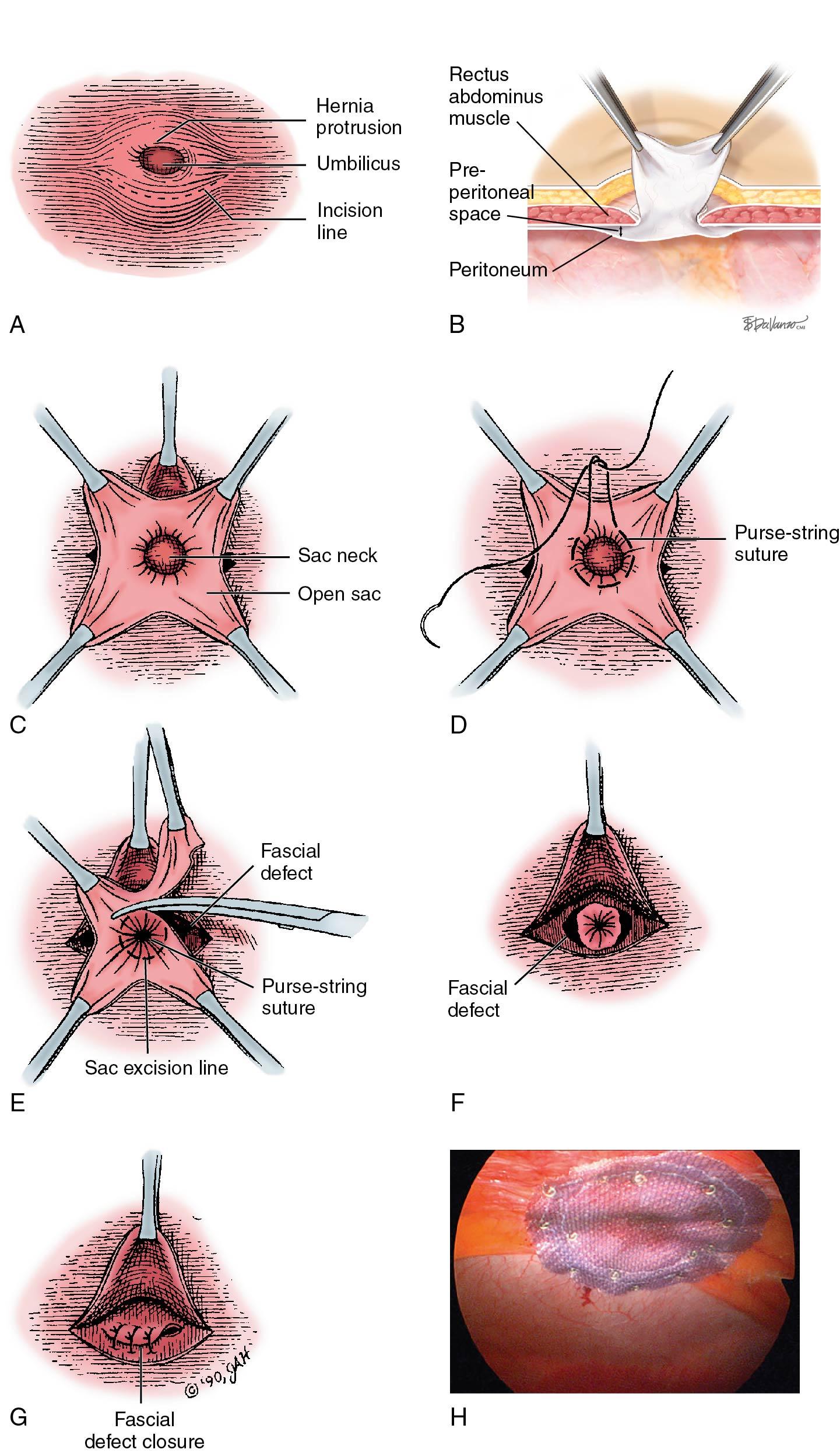
Incisional hernia surgical repair is too large of a topic to cover here; however, laparoscopic approaches are increasingly common, as is mesh use. In a meta-analysis of five randomized controlled trials involving 611 patients, the recurrence risk and length of hospital stay were similar, but laparoscopic repairs had reduced risk of wound infection compared with open repairs ( ).
For rectus abdominis diastasis, there is evidence that antenatal exercises reduce this risk of developing this condition; however, it is unclear if exercise postpartum helps. Surgical repair can be considered.
Prevention of incisional hernias bears mention because a hernia will develop in 10% to 15% of patients with abdominal incisions . Preventing wound infection with appropriate antibiotic prophylaxis if indicated and careful surgical technique is worthwhile because the hernia rate increases to 23% with postoperative wound infection. Choosing an off-midline incision has been shown to have fewer incisional hernias than midline incisions. A meta-analysis of abdominal fascial closure concluded that a continuous, slowly absorbing, monofilament suture closure resulted in the lowest rates of incisional hernia. A randomized trial comparing long stitch width (>10 mm) with shorter stitch width (5 to 8 mm) identified longer stitch width as an independent risk factor for the development of both incisional hernia (18% vs. 5.6%) and surgical site infection.
Weight loss and smoking cessation should be recommended because these are risk factors for hernia development.
Pelvic organ prolapse (POP) is a condition characterized by the failure of various anatomic structures to support the pelvic viscera. It is defined as the descent of one or more of the vaginal walls or cervix: anterior vaginal wall prolapse (cystocele, urethrocele, paravaginal defect) , posterior vaginal wall prolapse (rectocele or enterocele) , uterine/cervical prolapse, or vaginal vault prolapse (after hysterectomy, often with an enterocele) ( Fig. 20.5 ). Symptoms can include vaginal bulging, pelvic pressure, need to replace the prolapse ( splint ) to void or defecate, sexual dysfunction, vaginal bleeding or discharge, and low backache, or POP can be asymptomatic. Symptoms are more common when the prolapse extends beyond the hymen ( Fig. 20.6 ) ( ). POP usually involves more than one wall of the vagina.
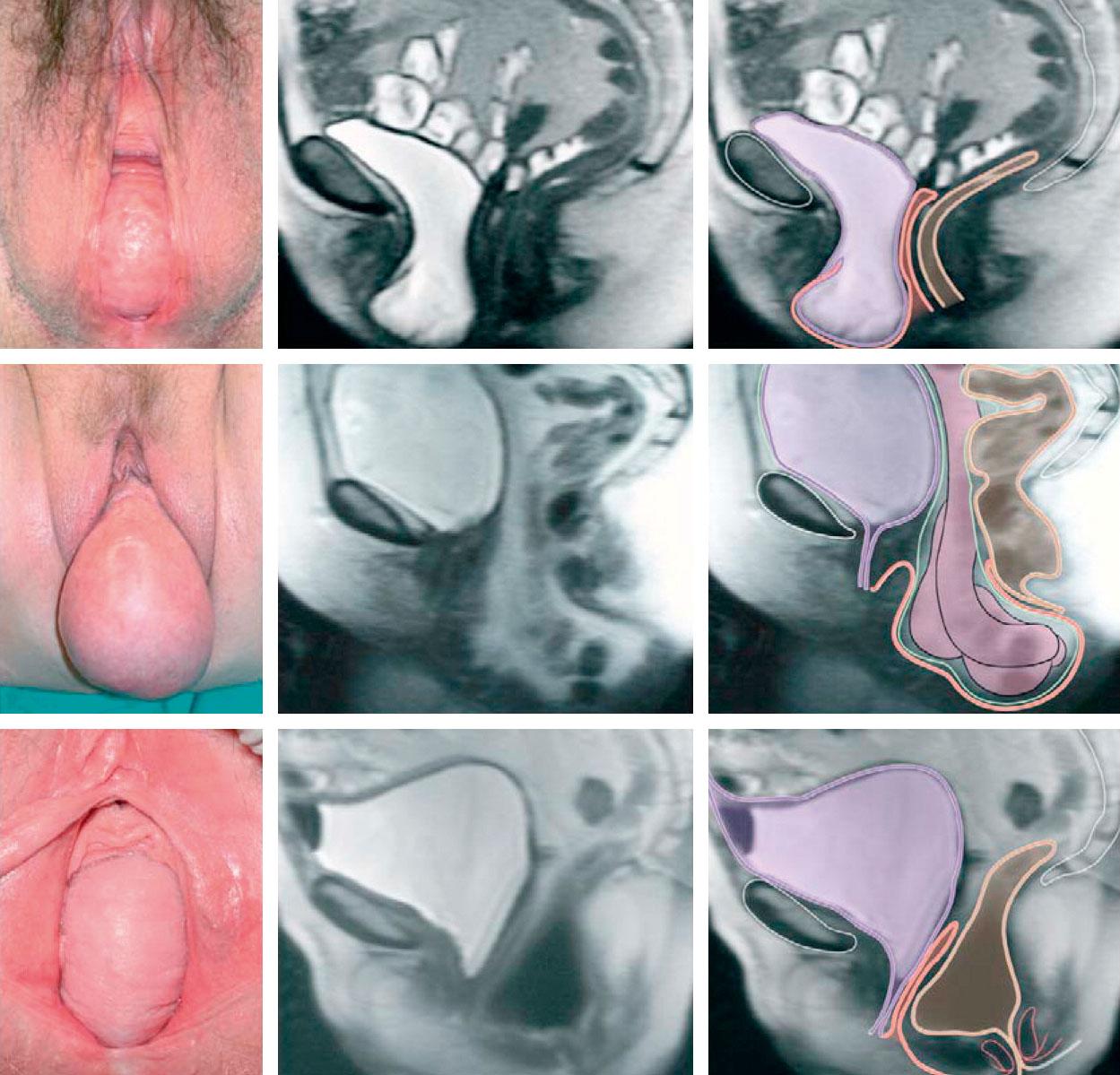

Present terminology for prolapse refers to anterior vaginal wall, posterior vaginal wall, and vaginal vault prolapse, making no assumptions regarding the organs behind the walls. This system has replaced terms such as cystocele, rectocele, and enterocele , which technically refer to the organs behind the walls of the vagina that are prolapsing. Cystocele, rectocele, and enterocele are still in wide clinical use and are appropriate with when it is known which organs are prolapsing behind the vaginal walls.
POP is common, particularly in parous women, although many are asymptomatic. The prevalence of POP is 30% to 50% ( ). The lifetime risk of undergoing prolapse surgery in the United States is 13% ( ), but most POP does not require treatment ( Fig. 20.7 ). The average age of women having surgery for prolapse is the mid-50s.

Pelvic support structure defects have been associated with age, parity, vaginal childbirth (neurologic or muscular injury or both), obesity, larger genital hiatus, menopausal status, chronic constipation, connective tissue disorders, genetics/family history, and neurologic diseases ( ; ) ( Box 20.1 ). A single vaginal childbirth is associated with up to 10-fold higher odds of POP, and the risk of surgery for POP may increase with each additional vaginal delivery ( ). In some cases, the injury from childbirth is subtle, but sometimes it is readily apparent, as shown in the images of this woman who had complete right-sided avulsion of her puborectalis (one of the levator ani muscles) after a normal vaginal delivery ( Fig. 20.8 ). Obstetric levator avulsion is strongly associated with POP. Of 453 participants who were 6 to 17 years from first delivery (median, 11 years), levator avulsion was identified in 15% and was more common among those who had undergone forceps-assisted delivery ( P < .001). Levator avulsion was strongly associated with prolapse beyond the hymen (OR, 2.7; 95% CI, 1.3 to 5.7) and with symptoms of prolapse (OR, 3.0; 95% CI, 1.2 to 7.3) ( ). Approximately 98% of prolapse surgery is performed on parous women, and 2% is performed on women who have never been pregnant . Compared with spontaneous vaginal delivery, cesarean delivery was associated with significantly lower hazard for POP ( ). It is unclear if prior hysterectomy for a non-POP indication is a risk factor for developing prolapse. White women appeared to have more overall symptom bother from prolapse, as well as more urinary symptoms, compared with black women, when assessed by validated questionnaire tools in a cohort of patients who underwent prolapse surgery. Compared with African American women, Latina and white women had four to five times higher risk of symptomatic prolapse, and white women had 1.4-fold higher risk of objective prolapse with leading edge of prolapse at or beyond the hymen.
Vaginal childbirth
Increasing parity
Aging
Obesity
Enlarged genital hiatus
Menopausal status
Chronic constipation/straining
Genetic component and family history
Connective tissue disorders (Ehlers-Danlos)
Neurologic injury
Prior pelvic surgery
Hysterectomy
Race and ethnicity
Irritable bowel syndrome
Episiotomy
Higher weight of the largest infant delivered vaginally
Chronic cough and respiratory diseases
Heavy lifting
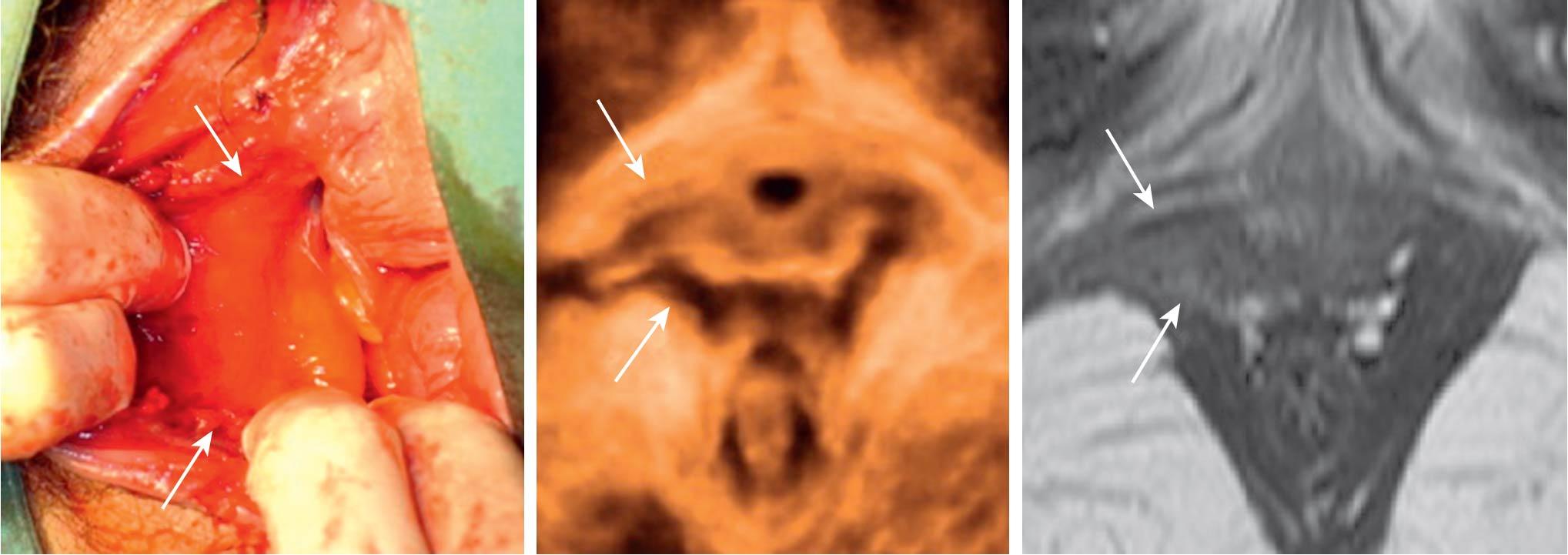
Recurrent POP after surgery remains a challenge, especially for the anterior vaginal wall. Risk factors for recurrent POP include age younger than 60 years in women who had vaginal surgery, obesity, and stage III or IV prolapse. Addressing modifiable risk factors before initial surgery might be important (e.g., obesity, chronic constipation). Suspension of the vaginal apex is associated with a decreased reoperation rate ( ).
Often, damage to the pelvic floor results in urinary incontinence instead of or in addition to POP. Urinary incontinence is discussed in detail in Chapter 21 .
Normal support of pelvic organs is provided by several key anatomic structures, including the pelvic floor muscles and connective tissue attachments ( Fig. 20.9 ). Level I support of the vaginal apex and cervix is provided by the uterosacral and cardinal ligaments and associated connective tissue, level II support of the midvagina is provided by connective tissue attachments to the arcus tendineus fasciae pelvis on the lateral pelvic side walls, level III support of the distal (inferior) vagina is provided by the perineal membrane and muscles ( ), and all of the attachments are connected through endopelvic connective tissue.
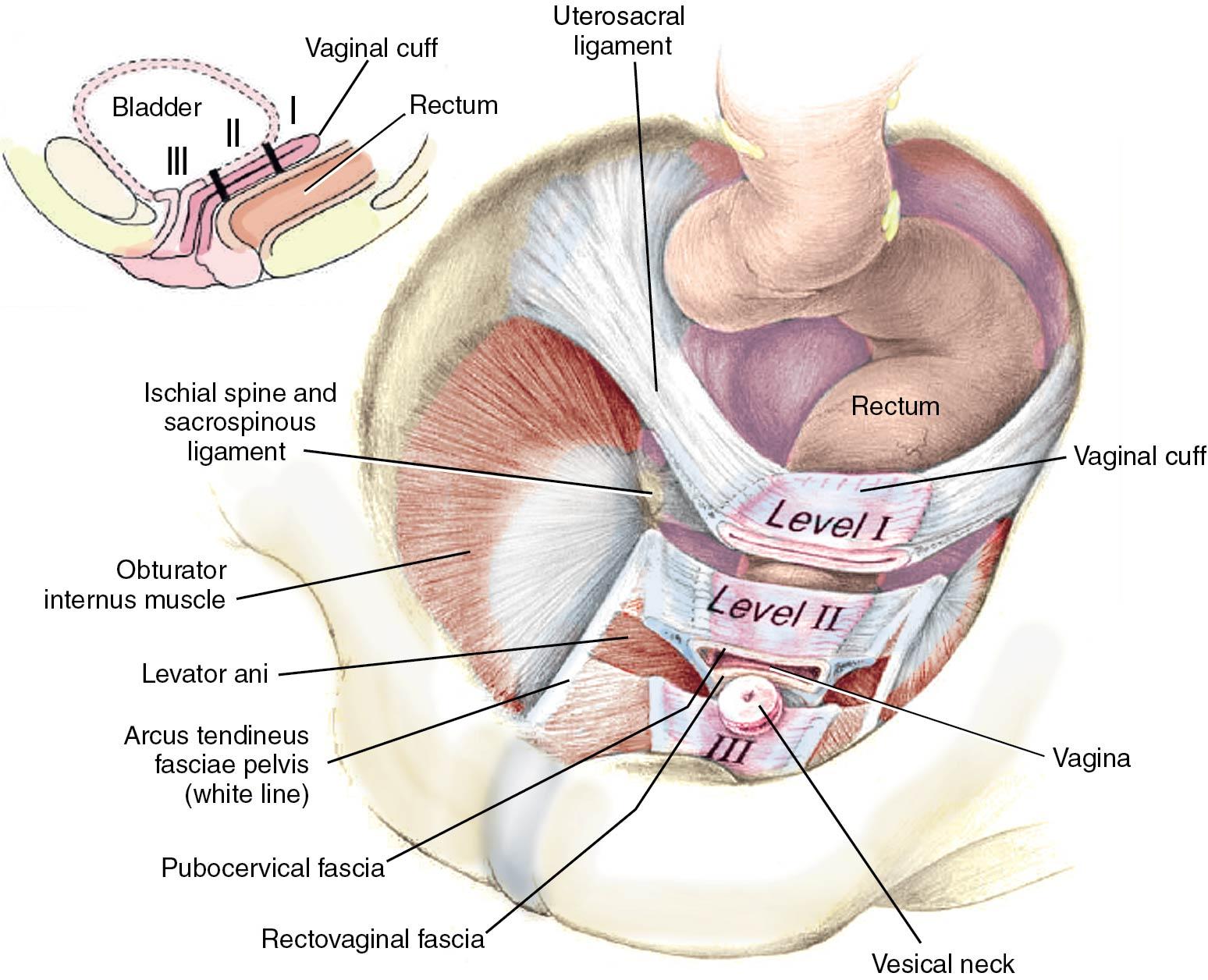
The vagina is a hollow, fibromuscular tube composed of three layers: nonkeratinizing stratified epithelium, lamina propria (loose connective tissue), and muscularis (fibromuscular tissue with collagen and elastin). It is supported by attachments to the sacrum, coccyx, and lateral pelvic sidewalls. In young, nulliparous women, the distal one-third of the vagina is oriented vertically and the upper two-thirds is oriented horizontally ( Fig. 20.10 ). Anteriorly the vagina supports the base of the bladder and urethra, posteriorly it supports the rectum, and superiorly it supports the small bowel. The vagina is fused with the vaginal muscularis inferiorly.
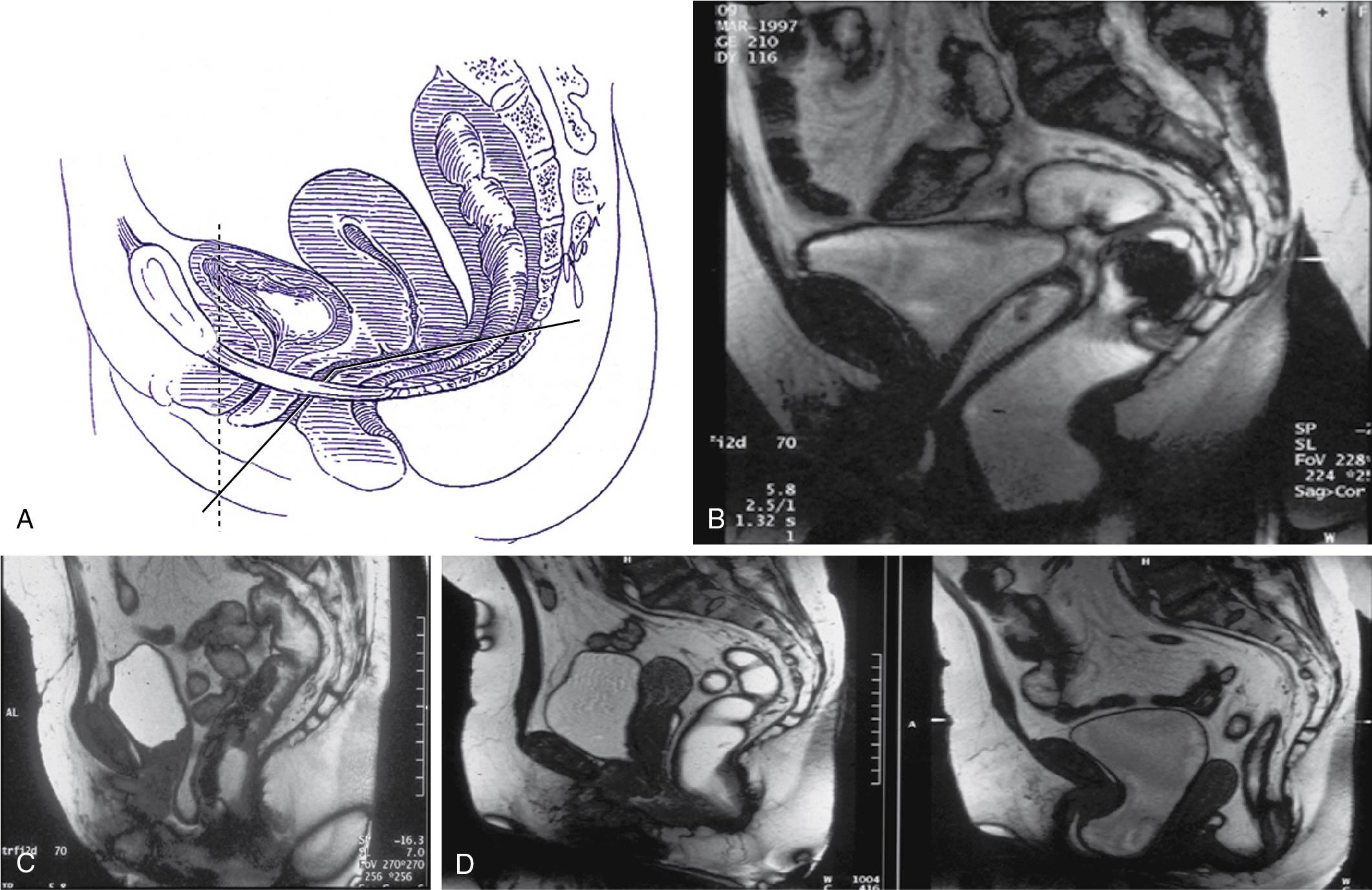
The pathophysiology of POP is probably multifactorial . Bump and Norton outlined a useful concept for looking at risk factors as predisposing, inciting, promoting, or decompensating ( Fig. 20.11 ). Although imaging is not usually necessary in the clinical evaluation of POP, imaging techniques, including ultrasonography and MRI, in research studies have improved our understanding of support defects. In one study, MRI three-dimensional (3D) color thickness mapping was used to compare the levator ani of 30 women: 10 asymptomatic, 10 with urodynamic stress incontinence, and 10 with POP. Loss of levator muscle bulk was found in women with POP and stress incontinence ( Fig. 20.12 ) ( ). Theoretic explanations for these findings include muscle atrophy from denervation from childbirth injuries, muscle wasting from muscle insertion detachment from childbirth injuries, or both. Remarkably, the pelvic floor muscles and pelvic support structures usually recover to a large extent after childbirth so that most women do not have symptomatic prolapse until later in life when the effects of aging combine with the childbirth injuries to result in clinically significant prolapse.
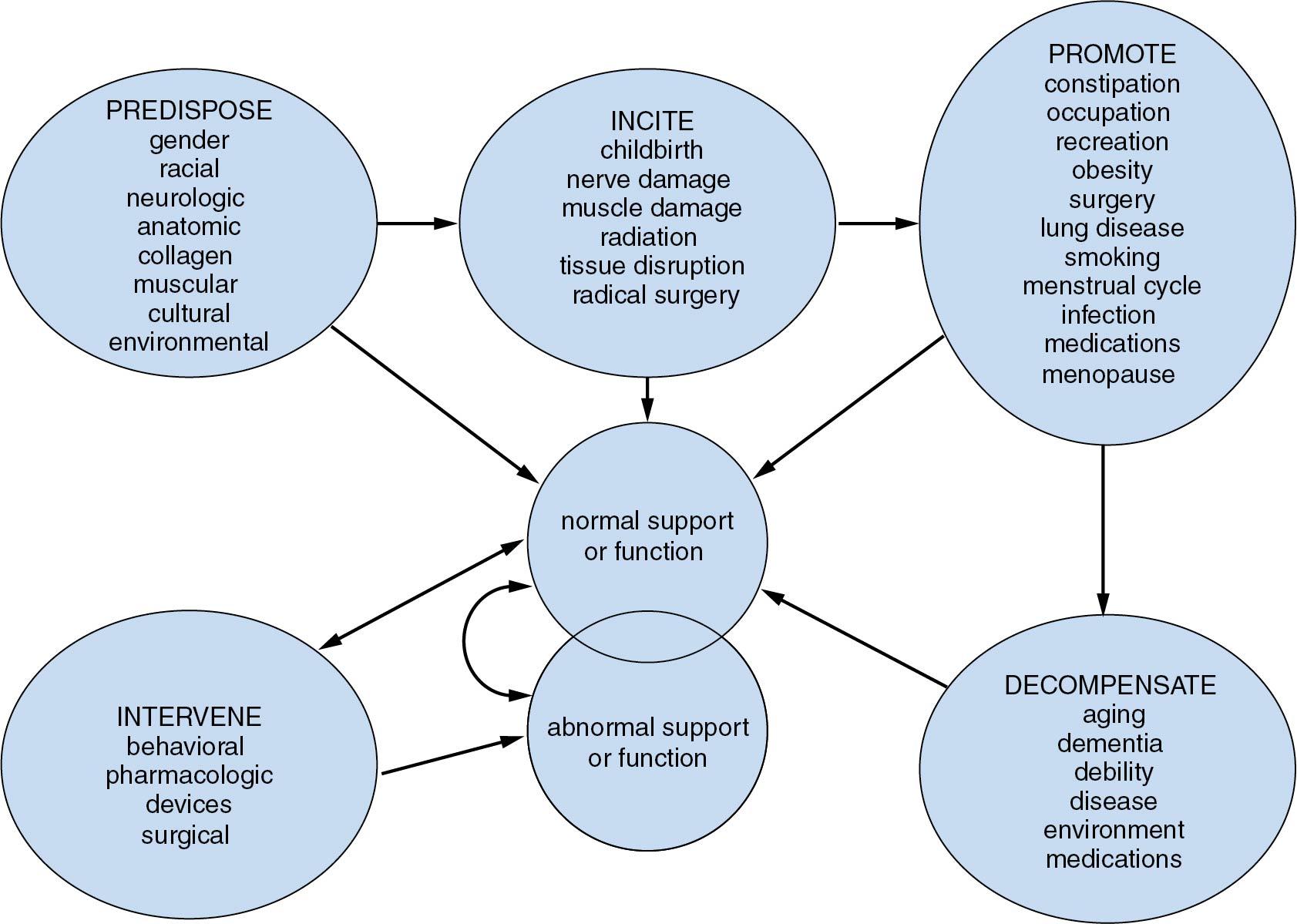
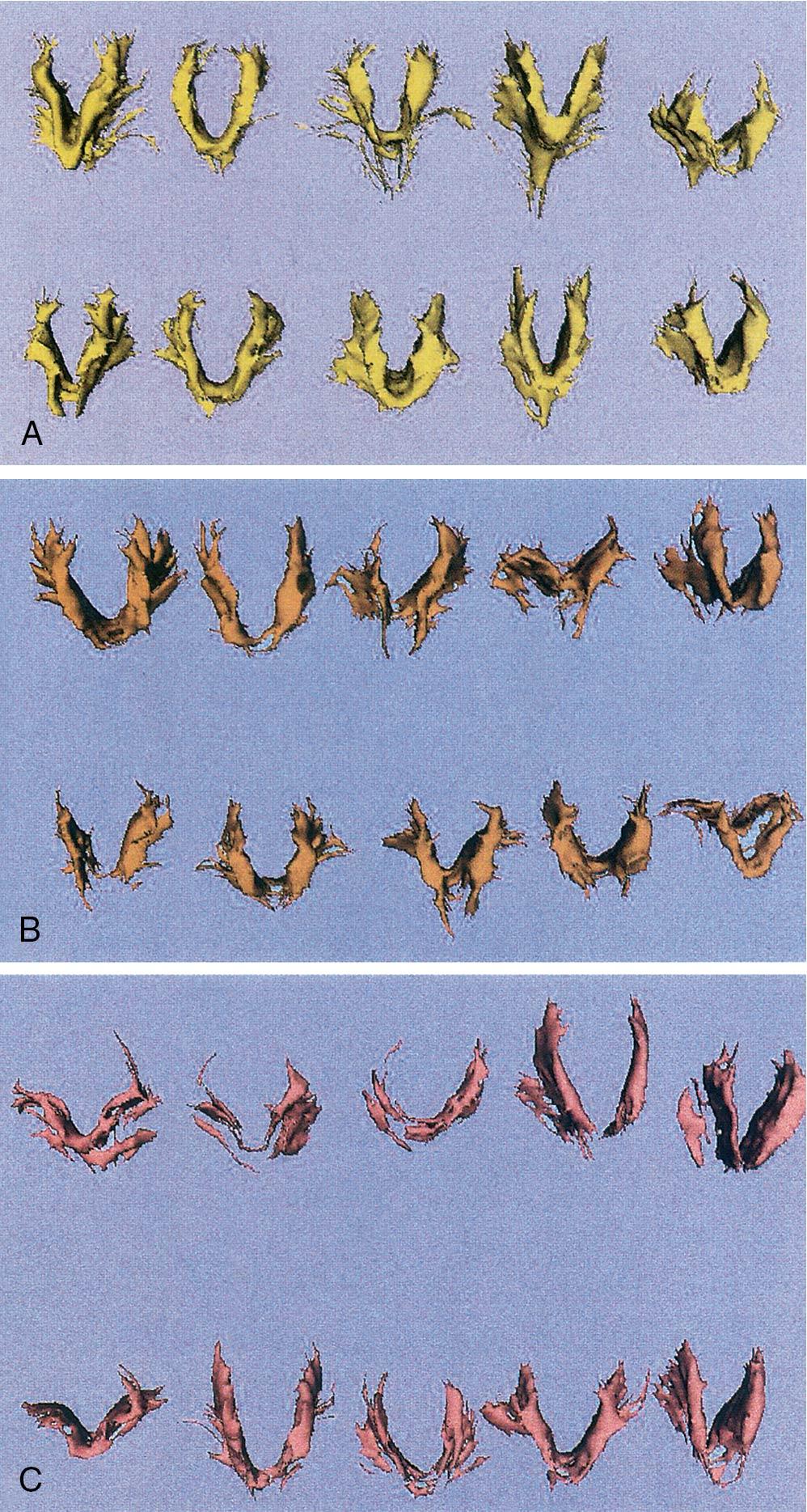
MRI studies of POP have also shown that women with POP have a more vertical vaginal axis and urogenital hiatus than women without POP. In young, healthy women without POP, the upper two-thirds of the vagina is nearly horizontal (see Fig. 20.10 ).
Symptoms of POP are often not specific to the area that is prolapsing, and many women have no symptoms. The classic symptoms of prolapse include vaginal heaviness, pressure and vaginal bulging. Because more than one pelvic floor disorder is often present, urinary, bowel, and sexual symptoms should be assessed in addition to prolapse symptoms in any woman with POP ( Box 20.2 ). Urinary symptoms associated with prolapse can include urinary incontinence, difficulty voiding, urinary urgency, slow urinary stream, splinting (reducing the prolapse) to void, or a sensation of incomplete bladder emptying. Bowel symptoms associated with prolapse can include constipation, straining, incomplete evacuation, fecal incontinence, or splinting to achieve bowel movements. Associated sexual symptoms may include discomfort, irritation, and decreased sexual desire. Vaginal bleeding might occur from erosions of exposed vaginal epithelium. Note that if a postmenopausal woman with prolapse has vaginal bleeding and there are no obvious erosions, a uterine source must also be considered. Back pain and pelvic pain are not reliably associated with prolapse.
Lower urinary tract symptoms
Urinary incontinence
Frequency, urgency, nocturia
Voiding difficulty: slow stream, incomplete emptying, obstruction
Urinary splinting
Constipation
Straining
Incomplete evacuation
Bowel splinting
Anal incontinence
Interference with sexual activity
Dyspareunia
Decreased sexual desire
Urinary incontinence with intercourse, orgasm
Pelvic pressure, heaviness, pain
Presence of vaginal bulge/mass
Low back pain
Tampon not retained
Quality-of-life effects
A patient with POP should also be asked about how her prolapse symptoms affect her quality of life, emotional health, and social interactions as well as whether or not they affect her ability to do usual daily chores, exercise, and participate in social events. Validated, self-administered questionnaires are available, such as the Pelvic Organ Prolapse Quality of Life (P-QOL) scale and the Pelvic Floor Distress Inventory, which cover these categories. Understanding the woman’s goals for treatment is important because often there are multiple symptoms in each of these areas that cause varying degrees of bother and distress.
If a woman with objective prolapse does not have any bothersome symptoms or evidence of associated medical risks such as urinary retention or renal impairment from urethral or ureteral kinking, she does not need treatment.
POP is best measured with a patient straining in the lithotomy position, although the physician should ask the patient if this reproduces her maximum bulge and, if not, repeat the examination in the standing position . Maximum prolapse is more likely to be observed with a full bladder in the standing position at the end of the day. All three compartments (anterior, posterior, and apical) should be individually assessed in all patients with prolapse . To observe and measure anterior vaginal wall prolapse, a retractor or posterior wall blade of a Pederson or Graves speculum is used to depress the posterior vaginal wall without artificially supporting the apex. The patient is then asked to strain, and the amount of anterior vaginal wall prolapse is noted. This is repeated by using one blade of the speculum to depress the anterior vaginal wall to evaluate the posterior vaginal wall. To assess apical descent, a measuring device such a uterine sound or POPQ (Pelvic Organ Prolapse Quantification) stick can be placed in the apex or the examiner’s finger can be placed on the vaginal vault or cervix while the patient strains.
It is important to measure or at least qualitatively assess all of the vaginal walls because often more than one compartment is affected. For instance, at least 85% of patient with anterior vaginal wall prolapse more than 1 cm outside the hymen have associated apical descent ( ). This is important to know for planning surgical correction because failure to address all areas of descent increases the risk of prolapse recurrence.
There are several systems for objectively measuring POP. In one system, prolapse into the upper barrel of the vagina is called first degree , prolapse is to the introitus is second degree , prolapse past the introitus is third degree , and complete eversion of the vagina is fourth degree prolapse. In the Baden-Walker system, grade 0 is normal position, grade 1 is descent halfway to the hymen, grade 2 is descent to the hymen, grade 3 is descent halfway past the hymen, and grade 4 is maximum possible descent ( ). Although these systems are commonly used and reasonable, they provide no information regarding which walls of the vagina are prolapsed and are rather imprecise regarding the severity of the prolapse, so in 1996 the Pelvic Organ Prolapse Quantification ( POP-Q ) system was developed (see the next section of this chapter) ( ). A comparison of these measurement systems is shown in Fig. 20.13 . Whatever system is used, it is important to measure all three compartments (anterior, posterior, and apical) and document the level of prolapse compared with the introitus or hymen while the patient strains.
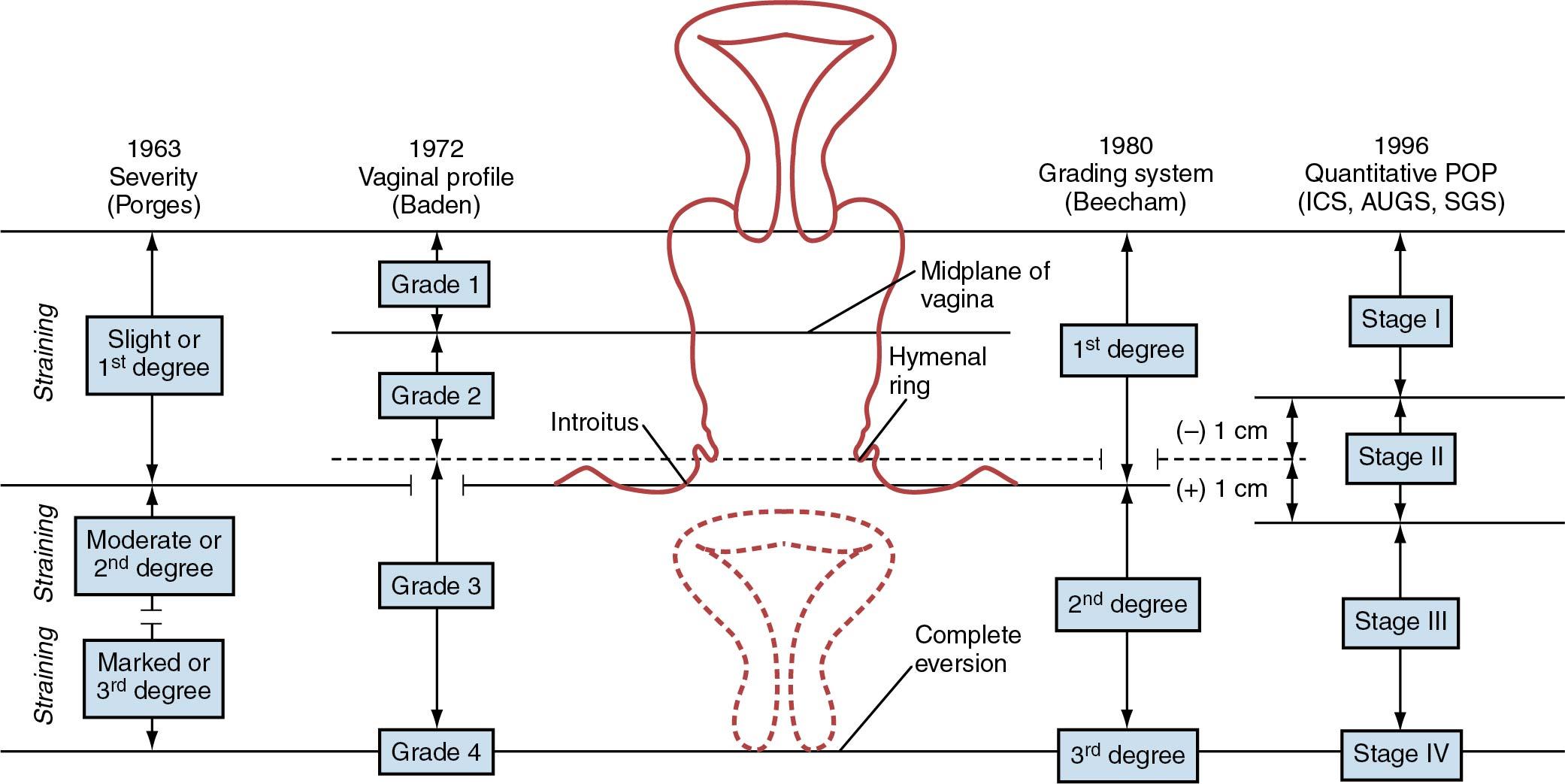
The degree of prolapse can vary by day depending on time of day and recent activities, so it is helpful to ask a patient if what you are seeing in clinic is what she experiences at home. In addition, if the prolapse measured while she is supine on an examination table does not reproduce the prolapse she reports, the examination should be repeated with the patient straining in a standing rather than supine position.
Vaginal tissues should also be checked for ulceration and bleeding. Pelvic floor muscle bulk, symmetry, and function should be assessed during the bimanual examination by asking the woman to tighten her muscles like she is trying to inhibit voiding or flatus. A bimanual examination of the uterus and adnexa, if present, should always be performed to screen for masses and help with surgical planning if indicated.
In 1996 the International Continence Society (ICS), the American Urogynecologic Society (AUGS), and the Society of Gynecologic Surgeons (SGS) adopted a standardized terminology for the description of female POP (anterior, posterior, and uterine/cervical or vault prolapse, as mentioned earlier) and a standard measurement system for POP: the POP-Q ( ). POP-Q is an objective, site-specific system for describing, quantifying, and staging pelvic support and was developed to enhance clinical and academic communication with respect to individual patients and populations of patients.
In the POP-Q system, as shown in Fig. 20.14 , all measurements except for total vaginal length (TVL) are performed while the patient strains (bears down). Point Aa is a point located in the midline of the anterior wall 3 cm proximal to the external urethral meatus and is roughly the location of the urethrovesical crease ( Fig. 20.15 ). Point Ba represents the most distal position of the anterior vaginal wall between Aa and the cervix or cuff. Point C represents either the most distal edge of the cervix or the leading edge of the vaginal cuff if a hysterectomy has been performed. Point D represents the location of the posterior fornix (pouch of Douglas) or the posterior point of attachment of the uterosacral ligaments (there is debate among the experts) in a woman with a cervix. In a patient who has no cervix, no D point is measured. Point Bp is the most distal of any part of the upper posterior vaginal wall between Ap and the cervix or cuff, and point Ap is a point located in the midline of the posterior vaginal wall 3 cm proximal to the hymen. These points should be expressed in centimeters above or below the hymen (i.e., negative measurements are above the hymen and positive measurements are below the hymen). PB, which is the length of the perineal body between the posterior vagina and rectum, and GH, which is the genital hiatus measurement from the urethra to the posterior vagina, are measured during strain and do not have positive or negative values because they are not compared with the hymen.
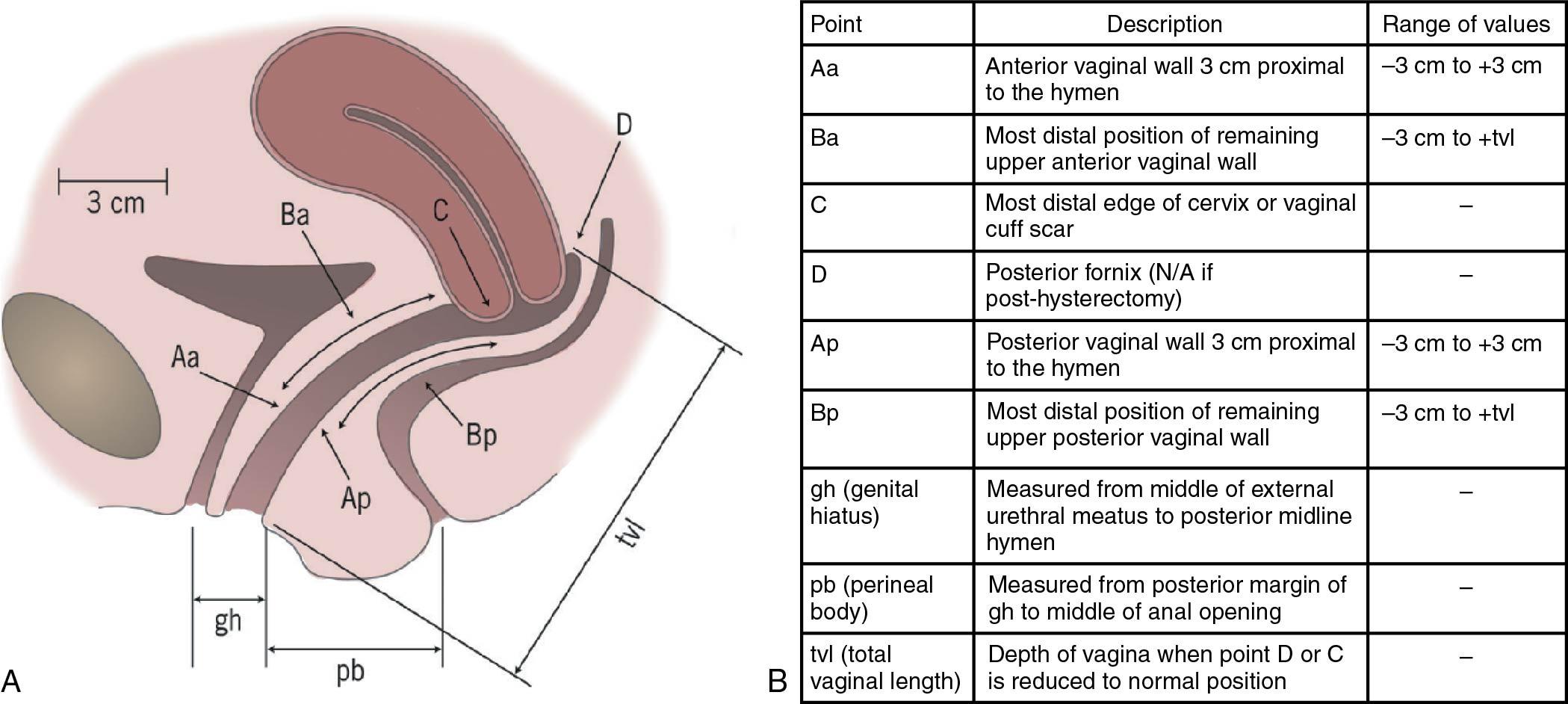
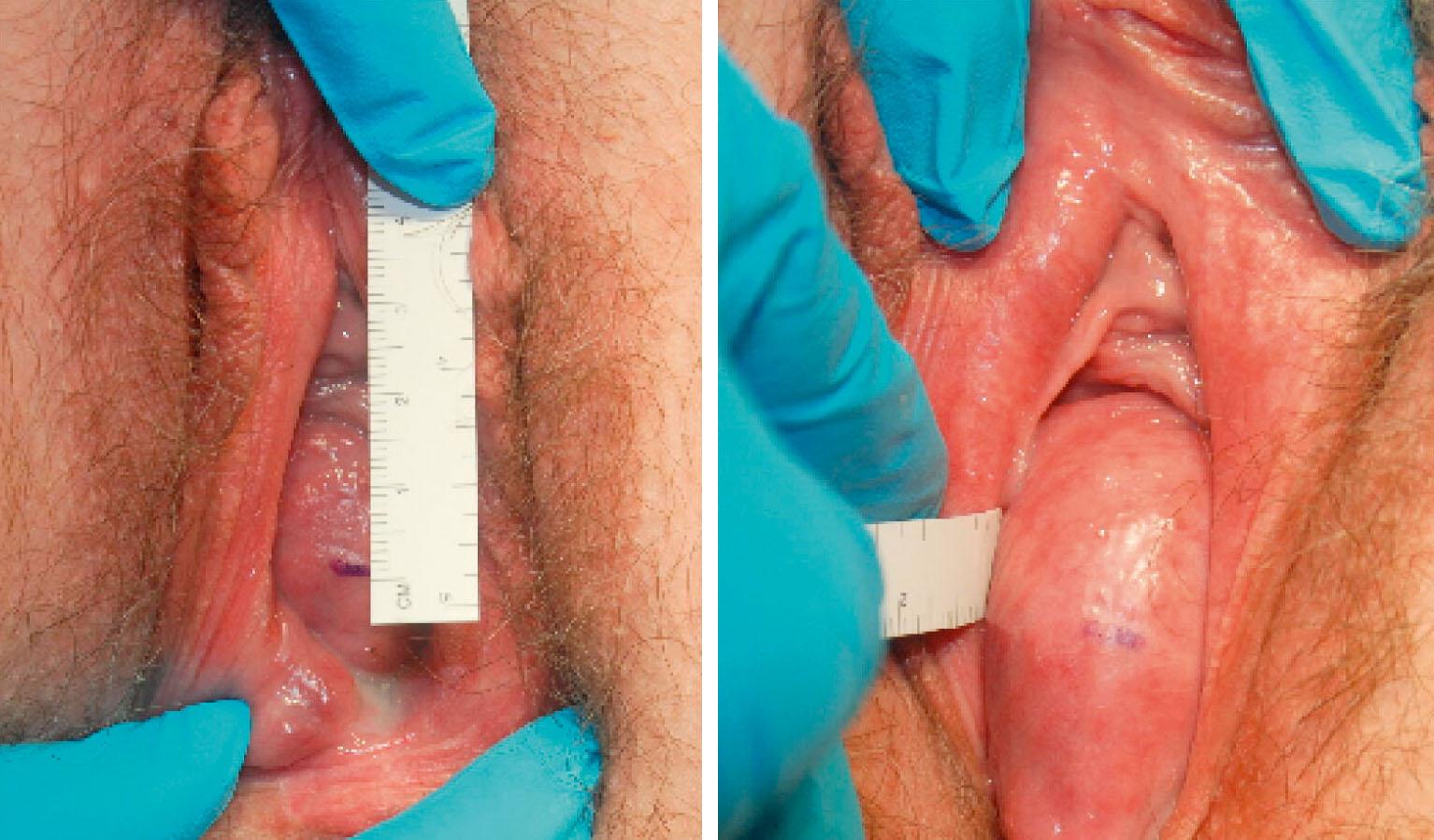
The most severe prolapse measurement on any of the vaginal walls can then be used to assign the stage of prolapse, as described in Box 20.3 : Stage 0 : no prolapse; stage I : the most distal prolapse is more than 1 cm above (inside) the hymen; stage II : prolapse between 1 cm above and 1 cm below (outside) the hymen; stage III : prolapse more than 1 cm beyond the hymen but no farther than TVL − 2 cm; and stage IV : complete eversion/procidentia.
No prolapse is demonstrated. Points Aa, Ap, Ba, and Bp are all at –3 cm, and either point C or D is between total vaginal length –2 cm.
Criteria for stage 0 are not met, but the most distal portion of the prolapse is more than 1 cm above the level of the hymen.
The most distal portion of the prolapse is 1 cm or less proximal or distal to the plane of the hymen.
The most distal portion of the prolapse is more than 1 cm below the plane of the hymen but protrudes no farther than 2 cm less than the total vaginal length in centimeters.
Essentially complete eversion of the total length of the lower genital tract.
The POP-Q provides a clear and complete description of a patient’s prolapse that facilitates effective communication between physicians and reproducible, meaningful measures for research.
If the patient is not bothered by the prolapse, it can be left alone and managed expectantly unless it causes urinary retention or hydronephrosis no matter what degree or stage it is . Patients can be advised to do pelvic floor strengthening exercises (i.e., Kegels, discussed in Chapter 21 ) with or without a pelvic floor physical therapist to decrease the risk that mild POP will progress and become symptomatic.
Treatment of vaginal wall prolapse may be nonoperative or operative depending on patient preferences and goals.
Women with mild to moderate (e.g., stage II) POP may elect for treatment with pelvic floor physical therapy and Kegel exercises, which can decrease the risk of prolapse progression and can be effective at improving the sensation of pressure from mild POP (Kegel exercises are described in Chapter 21 ). Pelvic floor physical therapy can also treat associated urinary, bowel, and sexual dysfunction.
There is reasonable evidence to recommend pelvic floor exercises. In one multicenter study, 447 women were randomly assigned to receive individualized pelvic floor muscle training or a prolapse lifestyle advice leaflet with no muscle training (control group). At 6 and 12 months, the women assigned to pelvic floor muscle training had fewer prolapse symptoms as measured by a prolapse symptom questionnaire (the Pelvic Organ Prolapse Symptom Score [POP-SS]) than the control group ( ). Another randomized controlled trial investigated morphologic and functional changes after pelvic floor muscle training in 109 women with stage I to III POP ( ). This supervised training led to a 44% increase in muscle strength, a 15% increase in muscle thickness, a decreased levator hiatus area, shortened muscle length, and elevation of the bladder and rectum positions. It took 6 months of muscle training to achieve these results, so this option requires motivated patients. A follow-up study by the same group reported that 11 (19%) of women in the exercise group improved one stage on the POP-Q system compared with 4 controls (8%). This improvement in stage corresponded with reduced frequency and bother of vaginal bulging and heaviness by 74% and 67%, respectively.
About half of patients cannot isolate their pelvic floor muscles to do Kegel exercises and need to be coached or taught how to do these exercises. Women who have performed Kegel exercises on their own and have not improved may still benefit from working with a physical therapist who can individualize muscle training and provide feedback and biofeedback to these patients. Pelvic floor strengthening has essentially no risks or side effects (unless a patient does too many and develops muscle soreness) and so should be offered to nearly all patients with POP.
Become a Clinical Tree membership for Full access and enjoy Unlimited articles
If you are a member. Log in here